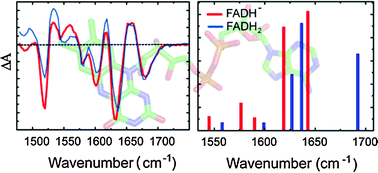Ultrafast transient mid IR to visible spectroscopy of fully reduced flavins
Abstract
The light sensing apparatus of many organisms includes a

* Corresponding authors
a
School of Chemistry, University of East Anglia, Norwich NR4 7TJ, UK
E-mail:
s.meech@uea.ac.uk
b
Department of Chemistry, Stony Brook University, Stony Brook, New York 11794-3400, USA
E-mail:
ptonge@notes.cc.sunysb.edu
c Central Laser Facility, Research Complex at Harwell, Harwell Science and Innovation Campus, Didcot, Oxon OX11 0QX, UK
The light sensing apparatus of many organisms includes a

 Please wait while we load your content...
Something went wrong. Try again?
Please wait while we load your content...
Something went wrong. Try again?
R. Zhao, A. Lukacs, A. Haigney, R. Brust, G. M. Greetham, M. Towrie, P. J. Tonge and S. R. Meech, Phys. Chem. Chem. Phys., 2011, 13, 17642 DOI: 10.1039/C1CP22097G
To request permission to reproduce material from this article, please go to the Copyright Clearance Center request page.
If you are an author contributing to an RSC publication, you do not need to request permission provided correct acknowledgement is given.
If you are the author of this article, you do not need to request permission to reproduce figures and diagrams provided correct acknowledgement is given. If you want to reproduce the whole article in a third-party publication (excluding your thesis/dissertation for which permission is not required) please go to the Copyright Clearance Center request page.
Read more about how to correctly acknowledge RSC content.
 Fetching data from CrossRef.
Fetching data from CrossRef.
This may take some time to load.
Loading related content
